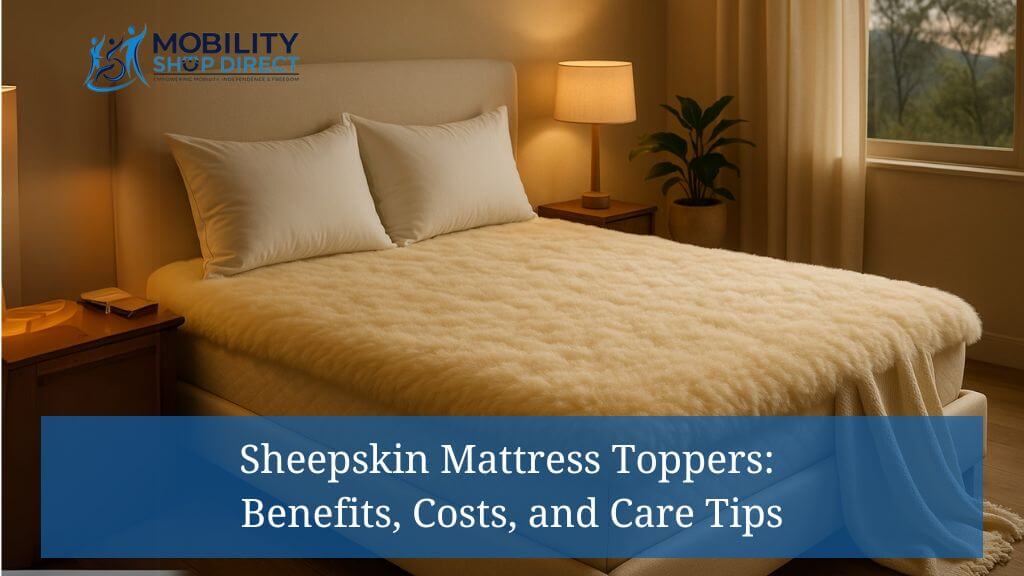What if your mattress topper could actually change the way you sleep; offering more than just a layer of comfort? Imagine upgrading your bedding to something that cushions your body, keeps your temperature steady year-round, cuts down on allergy triggers, and lasts for years with the right care. That’s what sheepskin mattress toppers bring to the table. They combine natural comfort and practicality in a way that outperforms synthetic options.
Still wondering if the higher price tag is worth it? Do hypoallergenic properties and sustainability actually make a difference in how you sleep? This article breaks down exactly what makes sheepskin toppers stand out. From temperature regulation and allergen resistance to cost comparisons, we’ll help you decide if one belongs on your bed.
Let’s look at what makes sheepskin toppers a smart and lasting choice for better sleep.
The Unique Benefits of Sheepskin Mattress Toppers
Natural Temperature Regulation: Year-Round Comfort
How Does Sheepskin Regulate Body Temperature?
Sheepskin's hollow wool fibers promote airflow, helping your body stay cool in the summer and warm in the winter. It’s like nature’s built-in thermostat; breathable and adaptable, so you stay comfortable no matter the season.
Why Sheepskin Is Perfect for Night Sweats
Wool naturally pulls moisture away from your skin and releases it into the air. That means you won’t wake up drenched or sticky. Compared to synthetic materials, which tend to trap heat and sweat, sheepskin stays dry and breathable.
Temperature Regulation Bedding vs. Synthetic Alternatives
Memory foam might offer contouring, but it holds on to heat. Sheepskin doesn’t. Its airflow keeps things cool and fresh, making it one of the most reliable year-round options.
Hypoallergenic Properties for Sensitive Sleepers
Allergies and Hypoallergenic Benefits of Sheepskin
If allergies disrupt your sleep, sheepskin may help. It naturally resists dust mites, mold, and mildew. Unlike synthetic bedding, which can off-gas or hold on to allergens, sheepskin offers a cleaner sleeping surface.
How Sheepskin Resists Dust Mites and Allergens
Sheepskin’s moisture-wicking keeps things dry, which dust mites and mold hate. Plus, wool has antimicrobial properties that help keep your sleeping space healthier.
Is a Sheepskin Mattress Topper Good for Asthma or Skin Sensitivities?
Yes. Sheepskin’s soft texture is gentle on eczema-prone skin and helps reduce asthma triggers by avoiding synthetic chemicals and allergens.
A Long-Term Investment in Comfort
Are Sheepskin Mattress Toppers Worth the Higher Price?
They’re not cheap, but they last. While synthetic toppers often flatten out or wear down in just a few years, a sheepskin topper keeps its comfort and performance for much longer.
How Long Do Sheepskin Mattress Toppers Last with Proper Care?
With regular brushing, spot cleaning, and the occasional airing out, a sheepskin topper can last over a decade.
Comparing Sheepskin Durability to Synthetic Mattress Toppers
Memory foam and polyester toppers tend to lose their shape quickly. Sheepskin, by contrast, holds up; keeping its texture and support even after years of use. Here’s a breakdown of how long they last in this care and cost guide.
Cost-Benefit Analysis: Sheepskin vs. Synthetic Materials
Why Choose Natural Wool Over Memory Foam?
Cost Comparison: Sheepskin vs. Synthetic Options
While synthetic options seem more affordable upfront, they often wear out quickly. Sheepskin toppers pay off long-term; no need to replace them every few years.
Performance and Longevity: Sheepskin vs. Petroleum-Based Materials
Wool naturally resists heat buildup and moisture. Synthetic toppers can’t compete on breathability or durability, as seen in this selection guide.
Natural Mattress Topper Benefits for Budget-Conscious Buyers
For anyone trying to make smarter long-term purchases, sheepskin makes sense. It helps you avoid constantly replacing lower-quality options.
Environmental Impact and Sustainability
Sustainable Bedding Materials: Sheepskin vs. Synthetic
Sheepskin is renewable and biodegradable. Synthetic materials, especially those made from petroleum, aren’t—they stick around in landfills for ages.
The Eco-Friendly Appeal of Sheepskin as a Renewable Resource
When it’s time to replace your sheepskin topper, it naturally breaks down. Synthetics don’t. That’s a major difference if sustainability matters to you.
Why Sheepskin Is the Natural Choice for Environmentally Conscious Consumers
Looking to reduce waste without giving up comfort? Sheepskin makes it easy. You’ll find more insights on this in this care-focused blog post.
Simple Care Tips to Maintain Softness and Freshness
How Do You Clean a Sheepskin Mattress Topper?
Brushing and Spot-Cleaning Basics
Brush regularly to prevent matting. For spills, use a damp cloth and wool-safe detergent. Avoid harsh cleaners; they can damage the fibers.
Sheepskin Mattress Topper Cleaning Guide: Detergents & Drying Tips
Use detergents made for wool and always air-dry your topper out of direct sun. Heat and sunlight can shrink or roughen the wool. More tips are available in this cleaning guide.
Preventing Wear and Tear with Regular Maintenance
Rotate your topper every so often and let it air out. These small steps go a long way in keeping it fresh.
Enhancing Durability Through Proper Care
How to Keep Your Sheepskin Mattress Topper Plush for Years
Fluff it often, avoid over-washing, and focus on spot cleaning to keep the fibers strong and soft.
Best Practices for Storing Sheepskin Bedding During Off-Season
Use a breathable cotton bag and store it in a cool, dry spot. Don’t use vacuum-sealed bags—they compress the wool and cause damage.
Troubleshooting Common Care Issues
If the fibers mat down, use a wool brush. For stubborn stains, reach out to a wool-cleaning professional.
Why Sheepskin Toppers Outshine Synthetic Alternatives
The Comfort and Health Edge of Natural Sleep Solutions
Sheepskin Toppers for Back Pain: What to Know
They help cushion pressure points and provide soft support; great for anyone with back or joint pain. You can read more on related benefits in this article.
Natural Wool Advantages Beyond Temperature Control
Wool is naturally antimicrobial and odor-resistant. It helps keep your bed clean and fresh without needing constant deep cleans.
Unique Sheepskin Features That Improve Sleep Quality
Softness, allergen resistance, and sustainability all come together in one product. That’s rare in the bedding world.
Final Comparison: Sheepskin vs. Other Mattress Toppers
Sheepskin vs. Memory Foam Toppers: Pros and Cons
Memory foam molds to your body but traps heat. Sheepskin stays cool and keeps its shape longer—offering a better deal for long-term comfort.
Natural Sleep Solutions or Budget Options: Which Is Right for You?
If short-term savings matter most, synthetic might do the job. But if you care about comfort, durability, and environmental impact, sheepskin wins.
The Enduring Appeal of Investing in Sheepskin Bedding
Sheepskin toppers are a lasting investment in better sleep. You can browse top options on this collection page.
Key Takeaways
- Temperature Regulation: Warm in winter, cool in summer; sheepskin adapts to your needs.
- Hypoallergenic Benefits: Fewer allergens, less irritation, better sleep.
- Exceptional Durability: One topper can last over a decade with good care.
- Sustainability: Wool is renewable and biodegradable.
- Easy Maintenance: Regular brushing and spot cleaning are usually all it takes.
Conclusion
A sheepskin mattress topper isn’t just about comfort; it’s about smarter sleep. It supports your health, lasts longer than synthetics, and cuts down on waste.
It’s also one of the few bedding options that truly balances comfort with responsibility. If you want a topper that feels good and does good, sheepskin’s the way to go.



